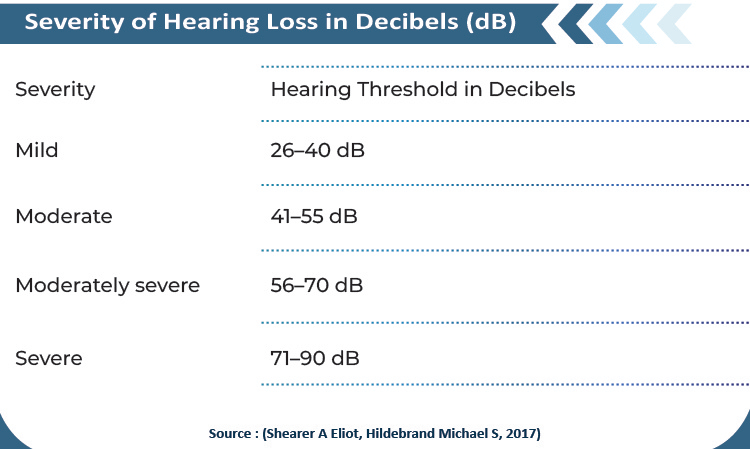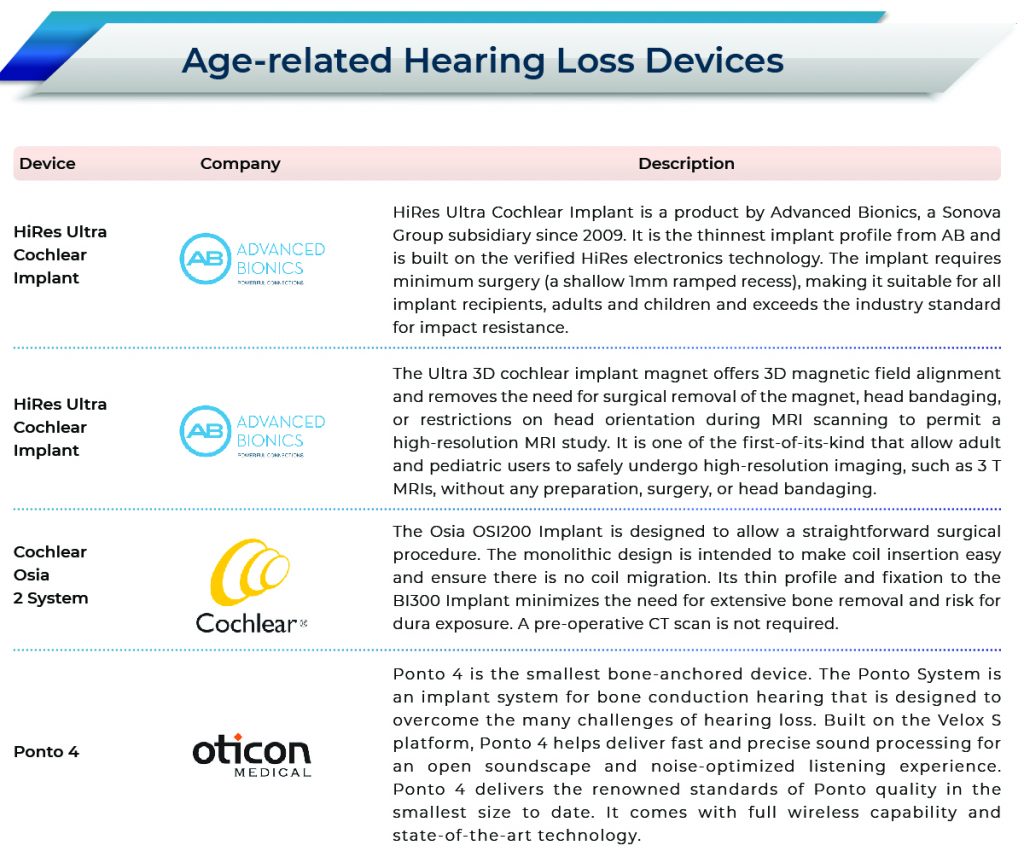Who is Going to be a Trendsetter in the Hereditary Deafness Market?
May 21, 2021
Table of Contents
Hearing loss is observed to be the most common sensory disorder. Hearing loss is found to be an etiologically diverse condition that is accompanied by various disease-related complications and major clinical, social, and implications affecting the quality of life. Approximately 50% to 60% of hearing loss patients are suffering due to genetic causes. Deafness can be observed as an inherited condition that is present when the baby is born. The development of inherited deafness can occur over a period of time during childhood or adulthood. According to the estimates of the American Hearing Research Foundation, there is about 1 birth in every 1000 to 2000 births that are born with congenital deafness. The result of this hereditary deafness can be due to many different types of genetic mutations which can be present at birth. There are some instances of genetic deafness that are a part of the disorder and can lead to another form of disability, but about 70-80% of the cases that have congenital deafness are a form of stand-alone disorder.
Syndrome Inherited Deafness
Downloads
Click Here To Get the Article in PDF
Recent Articles
- Unlocking the Future of Women’s Healthcare Market: The Promise of FemTech
- Establishment Labs Gains FDA Approval for Motiva Implants; Surmodics Receives 510(k) Clearance fo...
- Vektor Medical Receives CE Mark for vMap; Tosoh’s GR01 HbA1c Analyzer Gains FDA 510(k) Clea...
- Diagnostic Precision: The Rise of Medical Imaging Technologies and Market Trends
- Evaluating the Growing Role of Devices in the Rehabilitation of Hearing Impairment
According to the estimates of the CDC (Centers for Disease Control), almost about 20%-30% of the people that are born with hearing disabilities are prone to having other forms of abnormality. People born with deafness-related disabilities are also prone to other forms of developmental delays that can be a part of the genetic inheritance.
Genetic Inheritance of Deafness
The autosomal recessive deafness is seen to affect both the boys and girls equally. A parent who might/might not be deaf has the probability chance of 25% for transferring it to the child.
Autosomal recessive deafness 1A (DFNB1A) is caused by a mutation in the Gap Junction Protein Beta-2 (GJB2) gene on the chromosomal locus 13q11-q12. The connexin 26 (CX26) protein is encoded by the GJB2 gene. Connexin 26 is located in cells throughout the body, including the cochlea, and is responsible for maintaining K+ homeostasis in the inner ear. There has also been the discovery of a mutation in GJB3 and GJB6, but GJB2 remains the most common cause of hereditary deafness in many populations.
The mutation can also be among members of tight junctions CLDN14, responsible for maintaining the distinct ionic composition of compartments separated by epithelial barriers, the passage of solutes, and ions. Mutation in tricellulin (TRIC) can also cause deafness in humans as well. Pendred syndrome and Usher syndrome are the most common form of autosomal recessive forms.
There are a variety of different genetic mechanisms which can lead to deafness. Sex-linked deafness can occur from a mutation that has taken place on the X-chromosome. This kind of deafness can be seen mostly in boys. Girls are not that affected, as it takes two copies of the mutated gene in order to cause deafness in girls. The American Academy of Otolaryngologyclearly explains that autosomal dominant hearing loss is extremely rare and affects both boys and girls in equal ratio. A parent who is a carrier of the mutated gene has approximately 50% of the chances of passing it to the next generation.
Hereditary-associated hearing loss can be classified in different forms such as conductive, sensorineural, or mixed (a combination of both); syndromic or nonsyndromic; and prelingual or postlingual.
Types of Hereditary Hearing Loss and Deafness
- Conductive hearing loss
This type of hearing loss takes place from the abnormalities that are caused in the external ear and/or the ossicles within the middle ear.
- Sensorineural hearing loss
This type of hearing loss is caused due to the malfunctioning of the inner ear structures (for instance, the cochlea or the auditory nerve)
- Mixed hearing loss
This type of hearing loss involves both conductive and sensorineural hearing loss.
- Central auditory dysfunction
This type of hearing loss takes place due to the damage /abnormality in the eighth cranial nerve, auditory brain stem, or cerebral cortex.
Onset and Severity of Hereditary Hearing Loss
The prelingual hearing loss is observed to be present before speech development occurs. All congenital (present at birth) hearing loss is seen to be prelingual, but not all prelingual hearing loss is found to be congenital. Whereas, Postlingual hearing loss development takes place after normal speech development has taken place.

Hearing can be measured in decibels (Db). The threshold or 0dB mark for every frequency is known as the level at which the normal young adults tend to perceive a tone burst 50% of the time. The hearing capacity of an individual is perceived to be normal when an individual’s thresholds are found to be within 15dB of the normal thresholds. The severity of hearing loss can be seen in the table below:
Medical Devices as Treatments Options
- Hearing aids
Hearing aids are electronic devices that can be worn in or behind the ear region. The hearing aids help to increase the level of sound. It helps an individual dealing with hearing loss to listen, communicate and participate actively in daily activities of life. It helps people to hear in both quiet and noisy scenarios. A hearing aid is composed of three different parts: a microphone, amplifier, and a speaker. The hearing aid receives sound waves via the microphone, thus converting the sound waves to electrical signals and transfers them to the amplifier. The amplifier tends to ramp up the power of the signals and then sends them to the ear through a speaker. Some examples of hearing aids include Oticon Ruby and Oticon Xceed by Oticon Medical, among others.
As per Delveinsight’s analysis, it is estimated that the maximum number of people that are suffering from hereditary loss chose the option of hearing aids, as they are much affordable and accessible, and there is no such requirement of undergoing surgery.
- Cochlear implants
Cochlear implants are miniature-sized devices that are implanted surgically in the inner ear and provide a sense of sound to individuals that are profoundly deaf or hard-of-hearing. If the hearing loss in an individual is severe, he can be recommended a cochlear implant in both ears. Examples of Cochlear implants include the Naída CI Q Series from Advanced Bionics.
As per Delvesinsight’s secondary and primary analysis, an individual is only eligible for the option of cochlear implants when he is experiencing interrupted spoken communication.
- Bone anchored hearing systems
They are passed through the ear canal, and the middle ear and are constructed in such a way that they can use the body’s natural ability to transfer sound through bone conduction. The sound processor takes up the sound, transforms it into vibrations, and they send the vibrations via the individual’s skull bone to the inner region of the ear—for instance, the Ponto 3 SuperPower by Oticon Medical.
As per Delveinsight’s estimates, the physicians are less likely to recommend patients suffering from hereditary loss with bone anchored hearing systems due to the reason that hearing aids are a more handy option for patients.
- Assistive listening devices
These include telephones and cell phone amplifying devices, smartphone or tablet “apps,” and closed-circuit systems (hearing loop systems) at places of worship, theaters, and auditoriums.
- Lip reading/ Speechreading
It is considered to be an option that is helpful in individuals that are dealing with hearing problems and allows them to understand conversational speech. Individuals who utilize this method pay close attention to other people while they are talking, thereby understanding their lip and body movements.
Eligible Patient Population
Hearing loss is one of the most prevalent diseases affecting half of the people globally that are suffering from diabetes. According to the World Health Organization, ‘ disabling’ hearing loss can be referred to as the hearing loss that is greater than 35 decibels in the better hearing ear. Almost 80% of the people that are suffering from disabling hearing loss are present in low-income and middle-income countries.
According to the CDC, the prevalence rate of congenital hearing loss in the year 2017 was observed to be about 1.7 cases per 1000 babies that were being screened for hearing loss.
As per the estimates of the American Speech-Language-Hearing Association, there is a prevalence rate that varies in between 1 and 6 cases per 1000 newborns. According to the study conducted by Morton et al., the prevalence rate observed for congenital hearing loss was observed to be 1.33 cases per 1000 newborns. In England, where the compliance observed with confirmatory testing is high, the permanent childhood hearing loss can be defined as the bilateral sensorineural loss that is >=40 dB, and the incidents that were reported were found to be 1.33 cases per 1000 babies of 35 decibels or more in either of the ear, indicating the threshold for identifying patients for confirmatory testing, and since 30 to 40% of the detected hearing losses were found to be unilateral, 1.86 cases per 1000 births can be observed to be an average estimate for the incidence at birth.
Several studies that have been conducted by various universities, hospitals, and otolaryngology institutions across the world had stated that more than one child in 1000 is said to be born with hearing loss, and more than 50% of the prelingual hearing loss cases are observed to be hereditary.
According to a study that was conducted by Richard et al., more than 50% of all the prelingual cases are found to be hereditary in nature, whereas the left 40-50% of the cases are secondary where the cause is environmental factors that involve infectious or iatrogenic causes.
As per Delveinsight’s Hereditary Deafness market insights, many KOLs and doctors across the 7 MM region had indicated that I case out of 1000 new births is the ideal number that can be accepted for hearing loss on a global basis, whereas approximately 1 in 2 babies is found to develop hearing loss due to hereditary reasons.
As per Deveinsight’s assumptions that are used in the report, there are about 10% mild, 30% moderate, 35% severe, and 25% profound cases for hereditary deafness across the 7MM regions.
Delveinsight’s analysis of Hereditary Loss associated eligible patient population clearly showed that the maximum prevalence of people that were suffering from the hereditary loss was observed in the United States, followed by EU5, from the year 2018 to 2026.
Emerging Medical Devices
Acclaim® Cochlear Implant is an implanted device developed by Envoy Medical® Corporation and was granted the Breakthrough Device Designation by FDA in June 2020. The Acclaim is of its kind cochlear implanted devices and will be different from the traditional ones that are partially implanted and have an external microphone and processor. The device is still in study and, if approved, will be first without any external components to offer unique benefits to users and hopefully increase cochlear implant adoption and user compliance across the globe. The Acclaim cochlear implant uses the proven and novel sensor technology from the fully implanted Esteem® osseointegrated active middle ear implant.

Hereditary Deafness Market Activity
- On June 17, 2019, Cochlear implant had been granted the United States Food and Drug Administration’s approval of the new Cochlear™ Nucleus® Profile™ Plus Series Cochlear Implant and the Nucleus 7 Sound Processor’s new built-in connectivity featuring direct streaming with compatible Android™ smartphones.
- On July 07, 2020, Cochlear Limited had announced the premarket approval of Kanso 2 Sound Processor, the Nucleus 7 Sound Processor for Nucleus 22 Implant recipients, and the Custom Sound Pro fitting software.
- On February 18, 2021, hearing aid developer Signia had launched its newest line-up of Motion Charge&Go X hearing aids in the Hereditary Deafness market, which includes the breakthrough Motion Charge&Go SP X – a rechargeable super-power hearing aid that delivers hearing with up to 61 hours of run-time per charge.

Way Ahead
A lot of research studies in the Hereditary Deafness market have focused on the influence of hearing aid device usage among children relative to adults that are suffering from hearing loss. There are very few studies that are conducted on the hearing aid outcomes that meet the scientific criteria and even a few numbers of studies that are associated with the rehabilitation outcome and their correlation with hearing impairment-related disabilities or a handicapped individual.
Although these studies have come up along with the use and the satisfaction of the individual after their utilization of hearing aids and the barriers associated with their use, the clinical outcome parameters that can be used for the assessment of the safety and efficacy of these hearing aids devices are distributed widely.
The studies evaluating the efficacy of hearing aids are purely experimental studies wherein the influence of particular technical aspects or parts of the device are being researched upon comprising of very few study subjects, many of them are focused primarily on the technical outcomes instead of the clinical/functional outcomes that are associated with the hereditary loss. It is thus important to interpret results from these observational research studies as individuals who opt for hereditary aid are significantly different from the individuals that do not use the devices based on both measured/unmeasured factors.
Various improvements in terms of cochlear implants are expected in the future in the Hereditary Deafness market as they are very different from the conventional forms of implants and have an externally placed microphone and processor. Other technological advancements have also been worked upon by various companies that involve artificial intelligence assisted hearing aids, which analyze the surrounding environment of the wearer and the sounds that are coming, identification of specific sounds and specific people, and automatic adjustment of the audio based on the user’s level of hearing loss and priorly selected preferences.
Downloads
Article in PDF
Recent Articles
- Evaluating the Growing Role of Devices in the Rehabilitation of Hearing Impairment
- Nyxoah Secures FDA Nod for Genio® System in OSA Treatment; FDA Grants First 510(k) Clearance to D...
- Artificial Intelligence in Clinical Trials: Transforming Drug Development Efficiency and Precision
- Smart Inhalers: Redefining Respiratory Care with Technology and Data
- AI Stethoscope: Transforming the Stethoscope Market and Cardiac Diagnostics with Unmatched Accuracy



